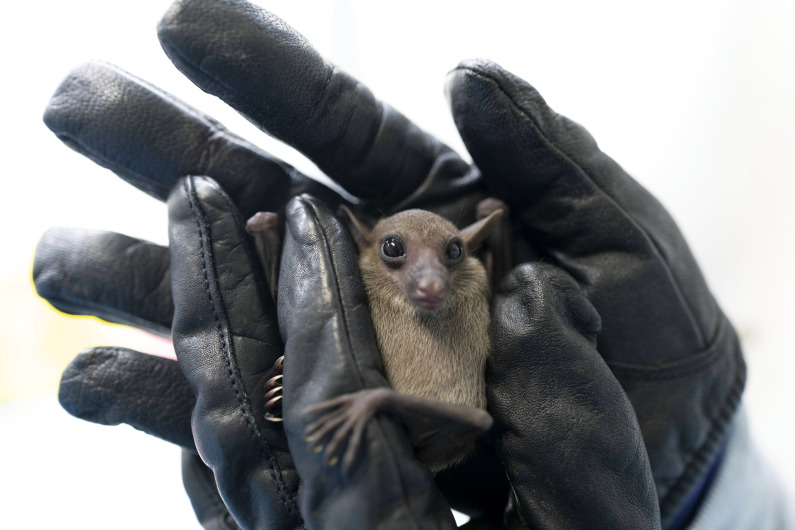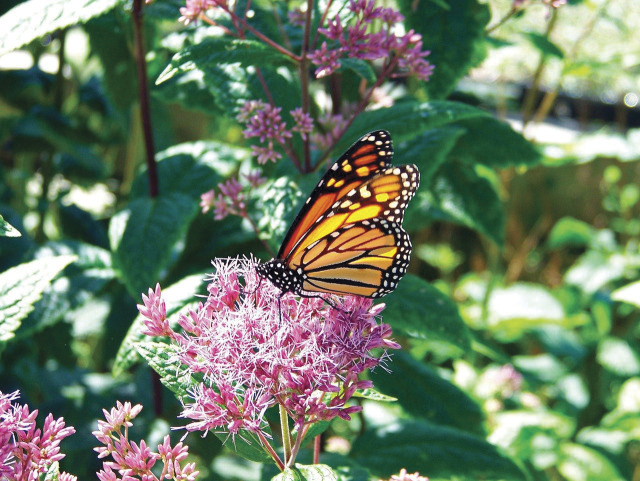How bats excel as viral reservoirs
Wild-caught cave nectar bat (E. spelaea).
Bats act as reservoirs of numerous zoonotic viruses, including SARS-CoV, MERS-CoV, Ebola virus, and, possibly, SARS-CoV-2, the pathogen behind the ongoing coronavirus pandemic. However, the array of molecular mechanisms bats deploy to tolerate pathogenic viruses remains unclear. Geraldine Goh, Matae Ahn, et al. (pp. 28939–28949) report that a lack of AIM2 receptors—pattern-recognizing immune receptors that sense intracellular DNA of pathogenic origin and trigger a cascade of events culminating in inflammation and cell death—in bats’ genomes might help tamp down bats’ inflammasome signaling pathway and sustain a viral reservoir. In vitro experiments in which genes for the human AIM2 receptor were introduced into bat kidney and immune cells resulted in partial restoration of inflammasome signaling, producing aggregates that mark the onset of an inflammatory response. Additionally, in black fruit bats (Pteropus alecto), the authors found reduced activity of the enzyme caspase-1, a key player in inflammasome signaling that triggers maturation and release of the cytokine IL-1β, which in turn helps mobilize immune defense and clear invading pathogens. Dampened caspase-1 activity was likely due to a pair of amino acid substitutions at positions 365 and 371 of the bat enzyme, compared with the corresponding mouse and human enzymes. Further, the authors identified a mechanism that balances caspase-1 activity and IL-1β maturation in a complementary manner in three bat species—P. alecto, Eonycteris spelaea (cave nectar bat), and Myotis davidii (David’s myotis)—to dampen inflammasome signaling and curtail the immune response. According to the authors, the findings suggest that bats have coopted different strategies, reducing caspase-1 activation, hampering IL-1β maturation, or both, to blunt immune responses against zoonotic viruses. — P.N.
Monarch butterfly range expansion, migration loss, and morphology
Monarch butterfly (Danaus plexippus). Image credit: Pixabay/PublicDomainPictures.
Migration has evolved repeatedly to enable organisms to exploit seasonal variations in resource availability. How migration-associated traits evolve remains unclear, particularly after loss of migration. To better understand the evolutionary relationship between migration and migration-related traits, Micah Freedman et al. (pp. 28887–28893) examined more than 6,000 museum specimens of monarch butterflies (Danaus plexippus) dating back to the mid-19th century. From their ancestral range in North America, monarchs have expanded across the Atlantic and Pacific Oceans during the past two centuries, and the expanded populations no longer migrate. Museum specimens representing the early stages of range expansions had larger and more elongated forewings than North American specimens. Specimens from Atlantic and Pacific locations exhibited significant decreases in forewing size and elongation over time, in contrast to specimens from either North America or from long-established nonmigratory populations in Central and South America or the Caribbean. Additionally, garden-reared, nonmigratory monarchs from Hawaii, Guam, Australia, and Puerto Rico had significantly smaller wings than North American migratory monarchs. The results suggest that migration-associated traits, such as large and elongated forewings, may be beneficial during initial range expansion, but not after the loss of migration, according to the authors. — B.D.
Water access inequality in US cities
Map of US households without piped water access, 2013–2017. Lighter areas have higher numbers of households without piped water. Clusters of plumbing exist in major cities and particular regions.
Plumbing poverty—the lack of piped water access in households—continues to be an issue in the United States, but the drivers and context of infrastructural inequality are unclear. Using census data from 2013 to 2017, Katie Meehan et al. (pp. 28700–28707) analyzed piped water access for households in the 50 largest US metropolitan areas. Between 2013 and 2017, approximately 471,000 households did not have running water in their homes. Although households without piped water were found in all US cities, they were primarily located in large cities with unaffordable housing markets and wealth gaps. Some of the wealthiest US cities exhibited the highest rates of plumbing poverty, including the metropolitan areas of San Francisco, Los Angeles, and New York. Compared with households with piped water, households without piped water were more likely to be nonwhite, low-income, tenants, and residents in mobile homes. Individuals in households without piped water were highly likely to contribute more than 30% of their gross income to housing costs and live in wealthy cities characterized by income inequality. The findings suggest that water access is a social, institutional, and racialized problem, according to the authors. — M.S.
How the brain controls rapid binocular eye movements
When human eyes track objects in 3D space, they undergo different types of movements based on where targets are located. Julie Quinet et al. (pp. 29123–29132) explored the neural mechanisms behind eye movements known as disjunctive saccades, in which eyes rotate in the same direction but by different amounts in order to view targets located at different distances and in different directions. Alternatively, the two eyes can move in unison, known as conjugate saccadic eye movements, or can rotate in equal but opposite directions, known as symmetric vergence eye movements. The authors used brain recordings from trained rhesus monkeys to investigate the role of neurons in the central mesencephalic reticular formation (cMRF), which anatomical studies have suggested may be involved in neural control of disjunctive saccadic eye movements. The authors identified a previously undescribed population of saccade-vergence burst neurons (SVBNs) located throughout the cMRF displaying a burst of spikes during disjunctive saccades that are highly correlated with vergence velocity, which is the speed at which eyes move toward or away from each other. These neurons fired regardless of the direction of the disjunctive saccade and showed no increase in activity during either conjugate saccades or symmetric vergence eye movements. According to the authors, SVBNs in the cMRF play a critical role in controlling the disjunctive saccades required to view targets in 3D space. — S.R.
How genetic codons may have evolved
Proteins are made of a set of 20 amino acids, which are encoded by a total of 61 codons, or sequences of three DNA bases. Glycine is thought to be the most primitive amino acid, but it has not been clear how codons for other amino acids evolved. Masayori Inouye et al. (pp. 28572–28575) analyzed 4,225 protein-coding genes in the Escherichia coli genome. The authors discovered a disproportionately greater usage of codons with the sequence AGY (wherein Y = U or C), compared with codons with the sequence UCX (wherein X = U, C, A, or G). The result suggests that these two sets of serine codons emerged independently during evolution. Based on a comparison of all the codons, the authors proposed a hypothesis for the multistage evolution of amino acids. At the time of the origin of life, glycine gave rise to serine encoded by AGY, in addition to valine, alanine, aspartic acid, glutamic acid, and arginine. Later in evolution, the seven primordial amino acids gave rise to serine encoded by UCX and the 13 remaining amino acids. This hypothesis contradicts previously reported results from prebiotic chemical experiments and meteorite analyses, which suggested that there were 10 primordial amino acids. According to the authors, the findings shed light on the origin of life and the genetic code. — J.W.
Antibody-mediated weight reduction in obese humans
Fibroblast growth factor 21 (FGF21) is a hormone that regulates metabolism, energy expenditure, and food consumption. Although modified FGF21 variants improve metabolic health and promote weight loss in humans, the frequent dosing required for these proteins to be effective limits their therapeutic potential. Amos Baruch et al. (pp. 28992–29000) report that the long-acting antibody BFKB8488A mimics the effects of FGF21. The authors tested BFKB8488A in humans in a phase 1a, randomized, blinded, placebo-controlled clinical trial with 60 overweight or obese participants. A single subcutaneous injection resulted in metabolic improvements that lasted up to 60 days. Moreover, BFKB8488A reduced body weight when the participants received calorically balanced standardized meals during a confinement period of 6 days. Body weight decreased by 1.20 kg in the treatment group, compared with 0.28 kg in the placebo group. However, body weight rebounded within 3 days after confinement. In addition, calorie consumption decreased starting 1 week after treatment and reached a maximum decrease of 50% between days 15 and 22. Specifically, the treatment reduced carbohydrate intake and increased aversion to sweet foods. Although further clinical trials are needed, the findings suggest that the experimental drug may represent a potentially safe and effective therapy for obesity and related metabolic conditions. — J.W.
Heat tolerance in corals
Egg–sperm bundles being collected from an Acropora millepora colony. The corals spawn at night, and researchers use red light to avoid disturbing the spawning colonies. Image credit: Phillip A. Cleves, Lorna Mitchison-Field, and Amanda Tinoco (Stanford University, Stanford, CA).
Coral reefs worldwide are under increasing threat from climate change-induced heat stress, which can lead to death by bleaching, defined as the loss of symbiotic algae that reside in and exchange nutrients with corals. However, relatively little is known about the molecular and cellular processes involved in coral heat stress and bleaching. Phillip Cleves et al. (pp. 28899–28905) used a technique called RNA-sequencing to examine heat stress-induced changes in gene expression in a coral relative, the sea anemone Aiptasia, which is symbiotic with algae similar to those found in corals. Within the first 3 hours of exposure to a high temperature (34 °C), 524 genes showed more than a fourfold increase in expression levels in symbiotic anemones. This early heat-stress response appeared to be driven in part by two proteins—nuclear factor kappa B (NFκB) and Heat Shock Transcription Factor 1 (HSF1)—that function as transcription factors regulating the activity of many genes. Next, the authors identified 337 genes whose expression levels were at least four times higher in symbiotic anemones compared with algae-free anemones. More than one-quarter of these putative symbiosis-supporting genes showed at least a threefold decrease in expression levels during the first 12 hours of heat exposure, many hours before bleaching occurred. According to the authors, this finding suggests that the heat-induced decrease in expression of symbiosis-supporting genes may trigger bleaching. In a related article, Phillip Cleves, Cory Krediet, et al. (pp. 28906–28917) used the genome-editing technology CRISPR/Cas9 to generate Acropora millepora coral larvae with mutations in the HSF1 gene. Little mortality was observed among mutant larvae exposed to 27 °C or among nonmutant larvae exposed to 34 °C for 48 hours. By contrast, nearly two-thirds of mutant larvae died during the 48-hour period of heat exposure, indicating that HSF1 plays an important role in protecting corals against heat stress. The findings suggest that coral populations with naturally high HSF1 expression levels may be resilient to climate change. According to the authors, the studies together shed light on coral biology and may guide conservation efforts aimed at predicting, preventing, and mitigating the effects of climate change on corals. — J.W.






